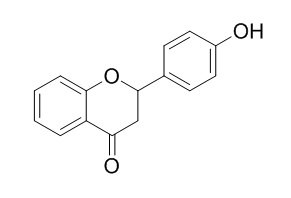4'-Hydroxyflavanone
4'-Hydroxyflavanone may have major potential as a pharmaceutical preparation against hepatic steatosis and dyslipidemia. 4'-Hydroxyflavanone shows full vasorelaxing effects; it also shows inhibition of nitric oxide production in lipopolysaccharide (LPS)-stimulated product of nitrite in RAW 264.7 cells with the IC50 value of 15.72 ug/mL.
Inquire / Order:
manager@chemfaces.com
Technical Inquiries:
service@chemfaces.com
Tel:
+86-27-84237783
Fax:
+86-27-84254680
Address:
1 Building, No. 83, CheCheng Rd., Wuhan Economic and Technological Development Zone, Wuhan, Hubei 430056, PRC
Providing storage is as stated on the product vial and the vial is kept tightly sealed, the product can be stored for up to
24 months(2-8C).
Wherever possible, you should prepare and use solutions on the same day. However, if you need to make up stock solutions in advance, we recommend that you store the solution as aliquots in tightly sealed vials at -20C. Generally, these will be useable for up to two weeks. Before use, and prior to opening the vial we recommend that you allow your product to equilibrate to room temperature for at least 1 hour.
Need more advice on solubility, usage and handling? Please email to: service@chemfaces.com
The packaging of the product may have turned upside down during transportation, resulting in the natural compounds adhering to the neck or cap of the vial. take the vial out of its packaging and gently shake to let the compounds fall to the bottom of the vial. for liquid products, centrifuge at 200-500 RPM to gather the liquid at the bottom of the vial. try to avoid loss or contamination during handling.
Nat Plants.2016, 3:16205
Nat Prod Sci.2014, 20(3):182-190
Fitoterapia.2021, 153:104995.
Prev Nutr Food Sci.2024, 29(4):563-571.
Am J Chin Med.2022, 1-20.
Molecules.2020 ,25(16):3697.
Korean Journal of Pharmacognosy2019, 50(4):285-290
J Applied Biological Chemistry2021, 64(2):185-192
Journal of Life Science2017, 233-240
BMC Complement Med Ther. 2020, 20(1):91.
Related and Featured Products
Naunyn Schmiedebergs Arch Pharmacol. 2004 Oct;370(4):290-8.
Vasorelaxing effects of flavonoids: investigation on the possible involvement of potassium channels.[Pubmed:
15378228 ]
A flavonoid-rich diet has been associated with a lower incidence of cardiovascular diseases, probably because of the antioxidant and vasoactive properties of flavonoids. Indeed, many flavonoids show vasorelaxing properties, due to different and often not yet completely clarified mechanisms of action. Among them, the activation of vascular potassium channels has been indicated as a possible pathway, accounting, at least in part, for the vasodilatory action of some flavonoid derivatives, such as apigenin and dioclein.
METHODS AND RESULTS:
Therefore, this work aims at evaluating, on in vitro isolated rat aortic rings, the endothelium-independent vasorelaxing effects of a number of flavonoid derivatives, to identify a possible activation of calcium-activated and/or ATP-sensitive potassium channels and to indicate some possible structure-activity relationships. Among the several flavonoids submitted to the pharmacological assay, only baicalein and quercetagetin were almost completely ineffective, while quercetin, hesperidin, quercitrin and rhoifolin exhibited only a partial vasorelaxing effect. On the contrary, acacetin, apigenin, chrysin, hesperetin, luteolin, pinocembrin, 4'-Hydroxyflavanone, 5-hydroxyflavone, 5-methoxyflavone, 6-hydroxyflavanone and 7-hydroxyflavone, belonging to the chemical classes of flavones and flavanones, showed full vasorelaxing effects. The vasodilatory activity of hesperetin, luteolin, 5-hydroxyflavone and 7-hydroxyflavone were antagonised by tetraethylammonium chloride, indicating the possible involvement of calcium-activated potassium channels. Moreover, iberiotoxin clearly antagonised the effects of 5-hydroxyflavone, indicating the probable importance of a structural requirement (the hydroxy group in position 5) for a possible interaction with large-conductance, calcium-activated potassium channels.
CONCLUSIONS:
Finally, glibenclamide inhibited the vasorelaxing action of luteolin and 5-hydroxyflavone, suggesting that ATP-sensitive potassium channels may also be involved in their mechanism of action.
Molecules. 2016 Sep 28;21(10).
New Diphenol and Isocoumarins from the Aerial Part of Lawsonia inermis and Their Inhibitory Activities against NO Production.[Pubmed:
27689981]
Lawsonia inermis Linn (Lythraceae), also known as henna, is a small shrub or tree distributed throughout Taiwan's Lanyu Island, in North Africa, and in Australia. Its leaves are used as a folk medicine for the treatment of external hemorrhage and fingernail abscesses.
METHODS AND RESULTS:
Investigation of the ethyl acetate (EtOAc)-soluble fractions from methanol extract of the aerial part of Lawsonia inermis has led to the isolation of a new diphenol, (Z)-4,4'-(prop-1-ene-1,3-diyl)diphenol (1), two new isocoumarin carbonates, inermiscarbonates A (2) and B (3), and six known compounds, 4'-Hydroxyflavanone (4), apigenine (5), kampferol (6), luteolin (7), quercetin (8), and (-)-catechin (9). Their structures were determined by detailed analysis of spectroscopic data and comparison with the data of known analogues.
CONCLUSIONS:
Compounds 1 and 4-9 were evaluated for the inhibition of nitric oxide production in lipopolysaccharide (LPS)-stimulated product of nitrite in RAW 264.7 cells with IC50 values of 5.63, 15.72, 8.67, 6.67, 6.17, 7.61, and 14.52 μg/mL, respectively.
FEBS Lett. 2012 Jun 21;586(13):1778-82.
4'-Hydroxyflavanone suppresses activation of sterol regulatory element-binding proteins and de novo lipid synthesis.[Pubmed:
22634867 ]
Sterol regulatory element-binding proteins (SREBPs) are major transcription factors that regulate the expression of genes involved in fatty acid and cholesterol biosynthesis.
METHODS AND RESULTS:
Here we show that 4'-Hydroxyflavanone (4'-HF) impairs the fatty acid synthase promoter activity and reduces the activation of SREBPs and their target gene expression in human hepatoma Huh-7 cells. Moreover, 4'-HF suppresses de novo fatty acid and cholesterol synthesis.
CONCLUSIONS:
This study identifies 4'-HF as an inhibitor of SREBP maturation and lipid synthesis, and provides evidence that 4'-HF may have major potential as a pharmaceutical preparation against hepatic steatosis and dyslipidemia.



